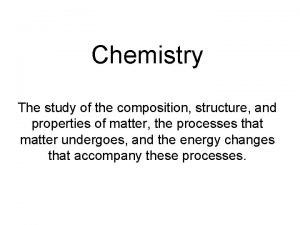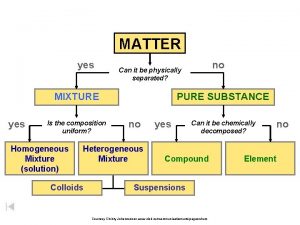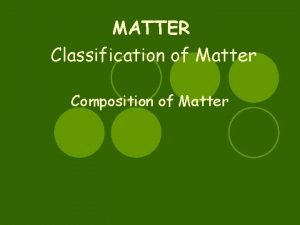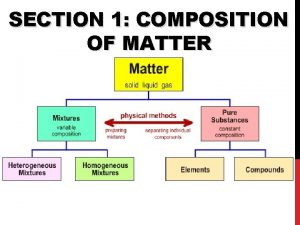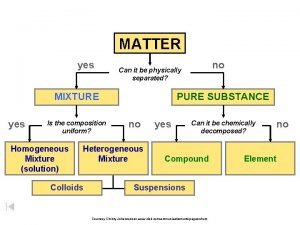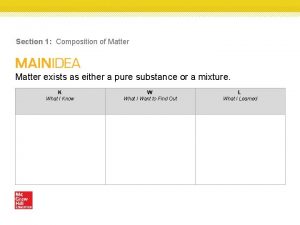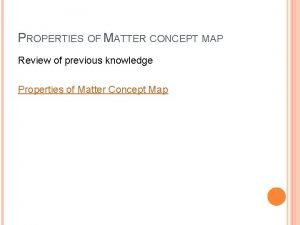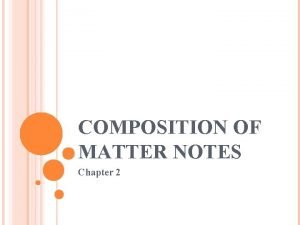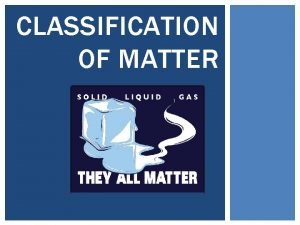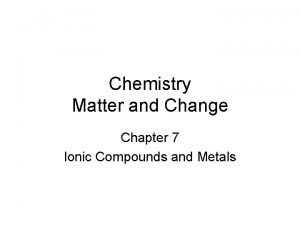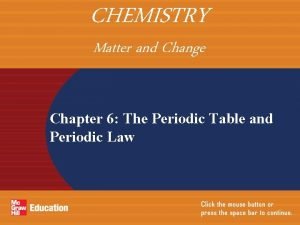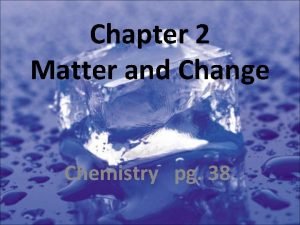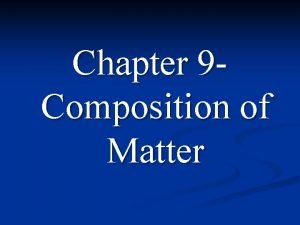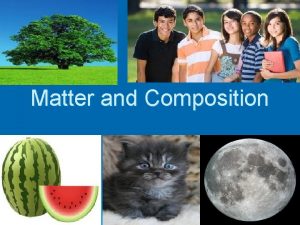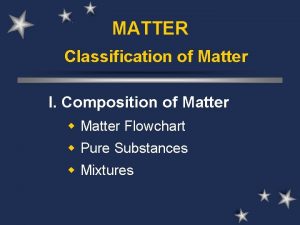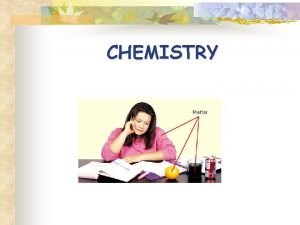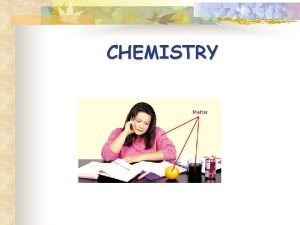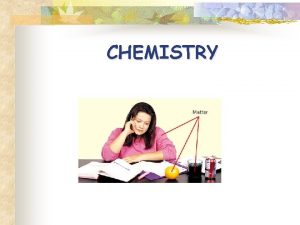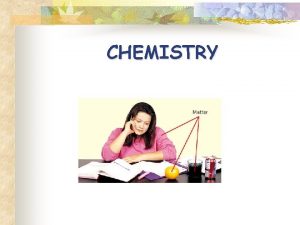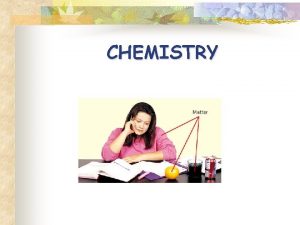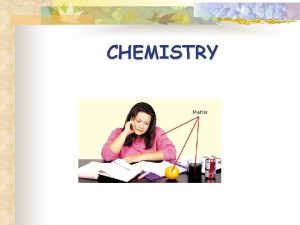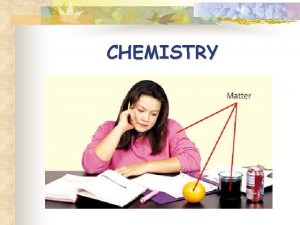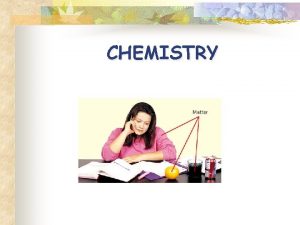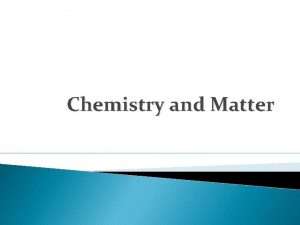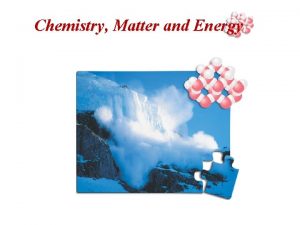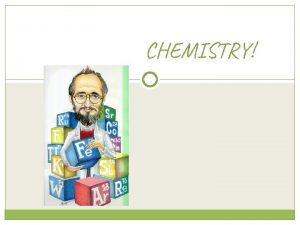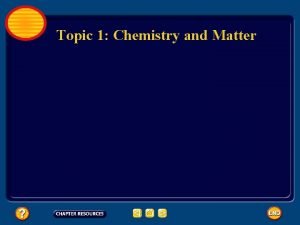Chemistry and Matter Chemistry The study of composition




























- Slides: 28

Chemistry and Matter Chemistry- The study of composition, structure, and properties of matter and changes they undergo. Chemical – any substance that has a definite composition (in terms of atoms that compose it) Branches Scientific Roles Organic Inorganic Basic Research Analytical Biochemical Applied Research Physical Nuclear Technological Application

Scientific Method What is it? ? ? Logical, systematic approach to solve a problem Four Steps: 1. Observe - collect data (qualitative – description / quantitative – numerical) 2. Hypothesize – proposed explanation that is testable 3. Test/Experiment – is the hypothesis correct? 4. Theorize – generalization that explains fact or phenomenon

Weight vs. Mass Are they the Same? Weight – measure of the earth’s gravitational attraction for matter Mass – measure of the quantity of “matter” By definition they are different… How would your weight change on the moon? On a mountain top? On the Sea floor? Weight Matter Mass 1. Occupies space and has mass 2. Displays inertia (resistance to change in motion) Law of Conservation of Matter(mass) – mass cannot be created nor destroyed

Matter Pure Substances Mixtures uniform and definite composition Elements 1 type of atom Na, Ag, H 2 , O 2 physical blend of two or more components Compounds 2 or more types of atoms bonded Homogeneous Mixture (Solution) Heterogeneous Mixture 1 phase 2 or more phases Bonded together Whole # ratios Na. Cl, H 2 SO 4, H 2 O Just mixed up Mixed up completely (uniform) Stainless steel, milk, salt water Mixed chunks you can see (not uniform) Granite, concrete, sand in water

Separating a Mixture • Differences in Physical Properties can be used to separate a mixture. (solubility, BP) • Filtration - Distillation

SOLID LIQUID GAS Has its own Takes shape of Fills container shape container Highest density Middle density Lowest density Not compressible Not Compressible compressible Little movement Some movement. Rapid movement

Periodic Table of Elements Non - metals Metals (On this side of the blue staircase) 18 Groups (Vertical columns) 7 Periods (Horizontal columns) Metalloids (Touch the blue staircase) blue staircase

Physical Change vs. Chemical Change Physical Change • does not change chemical character/composition of the substance • ex. Pounding…tearing into pieces, pulling, melting, boiling… Chemical Change • produces a substance with new chemical properties • Ex. rxn with H 2 O…rxn with acid or base…combustion Indications of a Chemical Change: 1. Change in energy Endothermic – energy is absorbed (feels cold) Exothermic – energy is released (feels hot) 2. Production of gas 3. Change in color 4. Formation of a precipitate (solid)

Properties of Matter Chemical Property – relates to substance’s ability to undergo change that transforms it into a different substance (change in matter) Physical Property – characteristic that can be observed without changing the identity of the substance (no change in matter) Extensive – depends on the amount of a substance present (ex. Length, mass, volume, solubility) Intensive – does not depend on the amount of a substance present (ex. Density, malleability, ductility, conductivity, color, melting point, boiling point

Lab Notebooks! • Take out lab notebook • Put your name, the block and my name on the front (in pen or sharpie) • Open to the front page and label at the very top “Table of Contents” • Label this page as page 1 (either top right or bottom right)

Table of Contents Example Page # *You need to include these 6 things!

Example #2

Label up to page #10 • Use the upper outer corner or the lower outer corner • Make sure it is uniform (always put it in the same place)

SKIP TO PAGE 5 • Title “Lab Techniques” • You should always start a lab on the right hand side • Go back to the table of contents and write in the information for Lab 1, “Lab techniques”

1. Title 2. Purpose • Pre-Labs Copy, or rephrase in your words 3. Prelab Questions • Rewrite question or phrase your answer so that question is obvious 4. Procedure • Rephrase & abbreviate (don’t copy verbatim!) 5. Data & Calculations • Make a table, chart, or designate an area to collect data and make calculations 6. Post Lab Questions • Same as prelab questions 7. Conclusion (only if applicable, completed after lab)

Scientific Notation • One non-zero digit to the left of the decimal • 0. 0098 m. L = 9. 8 x 10 -3 m. L • 1. 236 x 103 meters = 1236 meters • 602, 000, 000, 000 atoms = 6. 02 x 1023 atoms Know how to enter it into your calculator! (parenthesis are your friend)

Dimensional Analysis Introduction

Dimensional Analysis • Used to convert from one unit to the next • You may already do something similar in your head 1 foot = ? inches 1 yard = ? feet 2, 000 lbs = ? ton 1 dozen = ? eggs ? quarts = 1 gallon

Dimensional Analysis Helpful Conversions • 1 inch = 2. 54 cm • 1 ft = 12 in • 3 ft = 1 yard • 5280 ft = 1 mile • 4 quarts = 1 gallon • 4 cups = 1 quart • 16 tbsp = 1 cup • 1 mile = 1. 6 kilometers • 1 Liter = 1. 06 qt • 1 Kg = 2. 2 lbs K H D B d c m

Significant Figures Your new best friend

Significant Figures • What are they? • Numbers that can be counted as important • Why do we need them? • Auditorium example • Truck station example

Significant Figures • What are the rules? • Assume everything is significant except: 1. Zeros in the beginning 0. 001 0. 00987 0. 1 0. 000000000000000 07 2. Zeros in the end without a decimal point 1000. 100. 0 1. 000. 1000 3. Zeros not between two non zero numbers 305 5. 8904 89, 000, 001 506, 000 57050. 00500300

Significant Figures • How do we remember them? 1. Zeros in the beginning never count! 2. Zeros in the end only count if there is a decimal point ANYWHERE! 3. Zero sandwiches are delicious (and count).

Chemical Reactions Al + Cu. Cl 2 Cu + Al. Cl 3 Reactants Products (start) (end)

Recognizing Chemical Reactions • Possible Clues are: • Transfer of Energy • Endothermic – Heat is Absorbed (feels cold) • Exothermic – Heat is Released (feels hot) • Change in Color • Production of a Gas • Fizzing or Bubbling • Formation of a Precipitate • Solid that forms and settles out of a mixture

Accuracy and Precision Book: page 64 Accuracy: close to ACCepted value Precision: Repeating your results • A student determines the mass of a solid to be: 12. 36 grams 11. 57 grams 11. 06 grams 15. 57 grams 15. 58 grams 15. 59 grams The metal weighs 11. 59 grams. These are accurate The metal weighs 11. 59 grams These are precise

Density Definition: The ratio of the mass of an object to its volume: Book: page 90 -91 # 46 -48 *Be able to solve for all of the variables

Conservation of Mass • Mass is conserved in a Chemical Reaction. Reactants Products Mass of Reactants = Mass of Products grams (g) Reactants = grams (g) Products A + B C 5. 00 g + 7. 00 g = ? g
 Classification of matter section 1 composition of matter
Classification of matter section 1 composition of matter Composition of matter section 1
Composition of matter section 1 Section 1 composition of matter
Section 1 composition of matter Study of composition structure and properties
Study of composition structure and properties Is the composition uniform yes or no
Is the composition uniform yes or no Liquid information
Liquid information Whats gray matter
Whats gray matter Median and lateral apertures
Median and lateral apertures Gray matter and white matter
Gray matter and white matter What is grey matter
What is grey matter Matter flow chart
Matter flow chart Composition of matter section 1
Composition of matter section 1 Mixture is the composition uniform
Mixture is the composition uniform What is a matter flow chart
What is a matter flow chart What is composition in matter
What is composition in matter Composition of matter section 1
Composition of matter section 1 Classification of matter concept map
Classification of matter concept map Composition of matter flow chart
Composition of matter flow chart Number of proton
Number of proton A type of matter with a fixed composition
A type of matter with a fixed composition Chapter 2 matter section 1 classifying matter answer key
Chapter 2 matter section 1 classifying matter answer key Flow of energy vs flow of matter
Flow of energy vs flow of matter Chemistry matter and its changes
Chemistry matter and its changes Chemistry matter and change chapter 7
Chemistry matter and change chapter 7 Chapter 10 chemistry study guide
Chapter 10 chemistry study guide 1s 22 s22 p63 s23 p64 s2
1s 22 s22 p63 s23 p64 s2 Chemistry matter and change chapter 6
Chemistry matter and change chapter 6 Chemistry matter and change chapter 10 the mole answer key
Chemistry matter and change chapter 10 the mole answer key Chemistry matter and change chapter 2 answer key
Chemistry matter and change chapter 2 answer key



